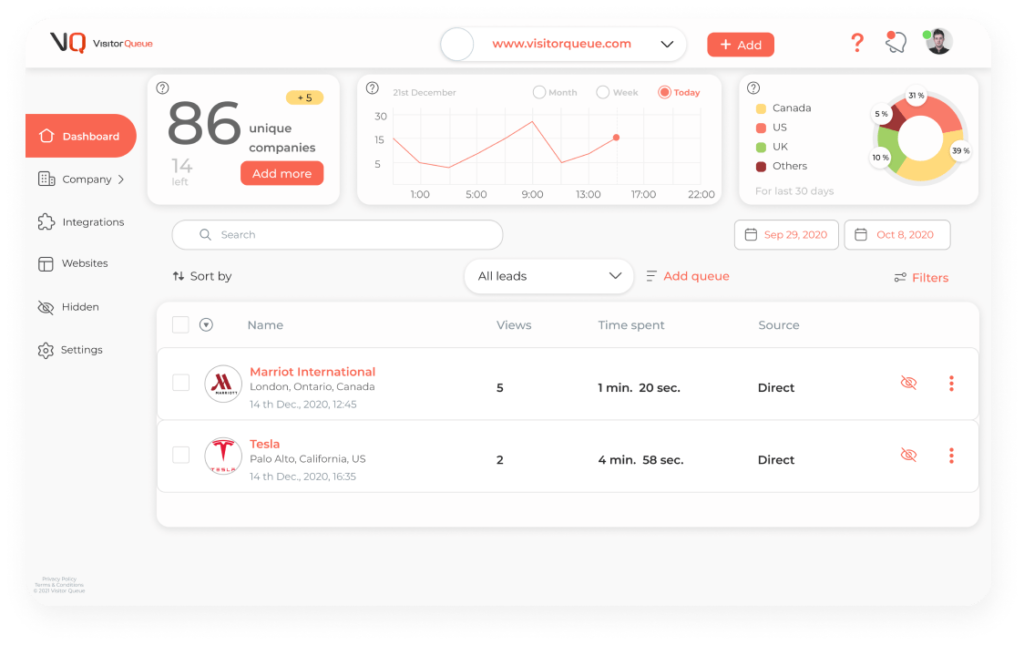Generating leads is only half of the battle. Knowing whether those leads are actually valuable is what separates good B2B marketing and sales teams from the great ones. That’s where lead generation KPIs come into play. These key performance indicators help you measure how effective your efforts are at turning prospects into qualified opportunities. In this article, we’ll break down the most important lead generation KPIs to track, how they fit into each stage of the sales funnel, and how to use them to improve both marketing performance and sales outcomes.
Well, What Are Lead Generation KPIs?
If you’re part of a B2B marketing or sales team, you’re likely familiar with the ongoing pressure to bring in more qualified leads. But how do you actually know whether your lead generation efforts are working? That’s where KPIs, or key performance indicators, come in. Lead generation KPIs are measurable values that help you understand how effectively your campaigns and strategies are attracting, engaging, and converting prospects into pipeline opportunities.
These metrics serve as the link between marketing activities and actual revenue. Without KPIs, your campaigns are just guesswork. With them, you can optimize, forecast, and prove ROI. Whether you’re managing paid search campaigns, building out gated content, running webinars, or dialing into cold leads, having the right KPIs in place lets you track performance with clarity and purpose. Before we jump into the most important KPIs you should be tracking, let’s take a quick look at how lead generation fits into the broader B2B sales funnel.
Understanding Your Sales Funnel
The B2B sales funnel typically spans multiple touchpoints, departments, and decision-makers. But regardless of the vertical or product, the stages of the funnel generally remain the same: awareness, consideration, decision, and action. Marketing usually owns the top and middle stages, while sales takes over as leads move further down the funnel.
Top-of-funnel (TOFU) strategies are all about capturing attention and increasing visibility—think blog content, social media, SEO, and display ads. Middle-of-funnel (MOFU) efforts center around engaging prospects with more specific, solution-oriented content like whitepapers, case studies, webinars, and email nurtures. Then comes the bottom-of-funnel (BOFU) where sales teams step in to qualify, pitch, and close. Tracking the right KPIs at each point helps ensure that every action your team takes is aligned with growth.
Why Lead Generation KPIs Matter
Without KPIs, it’s easy to fall into the trap of focusing on vanity metrics. A webinar may get 300 sign-ups, but how many of those actually turned into sales meetings? Your website may have thousands of monthly visitors, but what percentage submitted their information?
KPIs keep your team aligned on what success actually looks like. For marketers, this might mean improving conversion rates on landing pages or reducing cost-per-lead from LinkedIn ads. For sales reps, KPIs could involve speeding up follow-up times or increasing the percentage of MQLs that become SQLs. Now that you are familiar with the basics of lead generation KPIs, let’s go over the ones that you should be tracking.
Marketing KPIs for Lead Generation
There are different KPIs that marketing and sales teams should be monitoring in order to measure campaign performance. Here are the KPIs that your marketing team should be monitoring.
Marketing Qualified Leads
Not all leads are created equal. A marketing qualified lead, or MQL, is a lead that has shown enough interest and engagement to be considered ready for further nurturing or handoff to sales. How you define an MQL may vary. Some companies use lead scoring, while others track specific actions like attending a webinar or requesting a demo. Tracking MQL volume over time gives you a sense of how your content and campaigns are contributing to pipeline creation. You’ll also want to look at the quality of those leads by monitoring how many eventually convert to SQLs or opportunities.
Website Traffic and Engagement
It all starts with traffic. But, volume isn’t everything. What really matters is who’s coming to your site and what they’re doing once they get there. Website KPIs to monitor include unique visitors, time on page, bounce rate, and pages per session. These metrics help you understand whether your content is resonating with potential leads.
If you’re using a tool like Visitor Queue, you can go beyond surface-level traffic numbers and see exactly which companies are visiting your site, what pages they’re viewing, and how often they’re returning. This gives your team a clearer picture of buyer intent and account-level engagement.

Conversion Rate
Your conversion rate is one of the most important KPIs in all of lead generation. It measures how many visitors complete a desired action, such as filling out a contact form, downloading a whitepaper, or signing up for a newsletter. To calculate it, divide the number of conversions by the total number of visitors, then multiply by 100. For example, if a landing page gets 500 visitors and 50 form fills, your conversion rate is 10%. If that page is promoting a lead magnet tied to a specific campaign, you’ll want to compare that rate across other assets to determine what’s performing best.
Cost Per Lead
Cost per lead, or CPL, tells you how much you’re spending to acquire a new lead. It’s especially critical for paid campaigns across platforms like Google Ads or LinkedIn. You can calculate it by dividing your total campaign cost by the number of leads generated. If a $2,000 campaign brings in 40 leads, your CPL is $50. This KPI helps you prioritize marketing channels and optimize budget allocation based on performance.
Lead Source Performance
Knowing where your leads come from allows you to double down on the channels that bring the highest ROI. Whether it’s organic search, paid media, email campaigns, webinars, or referral partners, tracking the performance of each source over time provides valuable insight into what’s working and what’s not. You can set this up easily in your CRM or marketing automation platform. The goal is to see which lead sources consistently deliver high-quality leads that convert at a reasonable cost.

Sales KPIs for Lead Generation
While your marketing team creates awareness, your sales team is converting those leads into paying customers. Here are the sales KPIs your team needs to be tracking.
Sales Qualified Leads
Once a lead is handed off from marketing, it becomes a sales qualified lead, or SQL, if it meets certain criteria like budget, authority, need, and timing. The percentage of MQLs that become SQLs is a strong indicator of alignment between marketing and sales. If you’re seeing low conversion from MQL to SQL, it may signal a disconnect in lead quality or a need to adjust your scoring model. On the other hand, high conversion rates here indicate that your targeting and content strategy are spot on.
Lead Response Time
The faster your sales team responds to inbound leads, the higher the likelihood of engaging that prospect before a competitor does. According to various studies, responding within the first hour drastically increases your chances of making contact and setting a meeting. Tracking lead response time helps ensure your team is following up in a timely manner. If your average is too high, consider setting internal SLAs or using automation to notify reps immediately when a new lead comes in.
Contact Rate
Contact rate refers to the percentage of leads your sales team is actually able to reach. This is particularly important if you’re working with outbound lists, event leads, or cold data. A low contact rate could suggest issues with your outreach timing, messaging, or data quality. Improving contact rates often starts with refining your outreach cadence, ensuring accurate data, and using tools that support multichannel engagement.
Meeting Rate
This KPI tracks how many leads convert into actual sales conversations. A meeting might be a discovery call, product demo, or initial consultation, whatever step moves the lead closer to a decision. Meeting rate is an important indicator of lead intent and sales rep performance. If your meeting rate is low, revisit your outreach messaging or lead scoring. You might be handing off leads too early or missing key follow-up opportunities.

Opportunity Creation Rate
Once a lead has been qualified and a meeting has occurred, the next goal is to convert that engagement into a real opportunity. Opportunity creation rate measures the percentage of leads that make it into your pipeline. This is an important KPI for both marketing and sales, as it reflects the true value of your lead generation efforts. High traffic and form fills mean little if they don’t turn into pipeline revenue.
Connecting KPIs to Revenue
At the end of the day, the goal of any lead generation program is revenue growth. Every KPI should tie back to that goal, either directly or indirectly. If your campaigns are bringing in thousands of leads but none are converting to sales, it’s time to revisit your messaging, targeting, or qualification process.
One of the best ways to connect marketing efforts to closed deals is by calculating your lead-to-close rate. This is the percentage of total leads that become customers. If you know your average deal size and your close rate, you can estimate how many leads you need to hit your revenue targets. For example, if your average deal size is $10,000 and you close 5% of your leads, then every 100 leads generate $50,000 in revenue. From there, you can work backwards to set campaign goals and budget accordingly.
Final Words
Lead generation shouldn’t be a guessing game. The lead generation KPIs outlined above offer a clear window into how your efforts are performing at every stage of the funnel, from initial engagement to pipeline creation. For your marketing and sales teams, success comes from collaboration and data. When both sides are aligned on what to track, how to measure it, and what actions to take based on performance, the result is more qualified leads, faster sales cycles, and better use of your resources. If you have any questions about how Visitor Queue can identify your website visitors, do not hesitate to reach out.
 Identify
Identify Personalize
Personalize Benchmark
Benchmark Agencies
Agencies Integrations
Integrations Case Studies
Case Studies Use Cases
Use Cases Blog
Blog Resources
Resources









